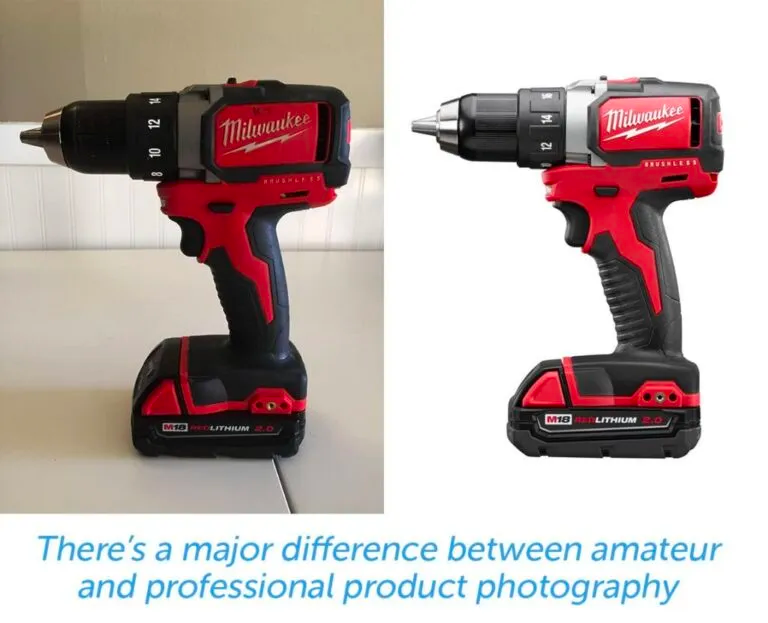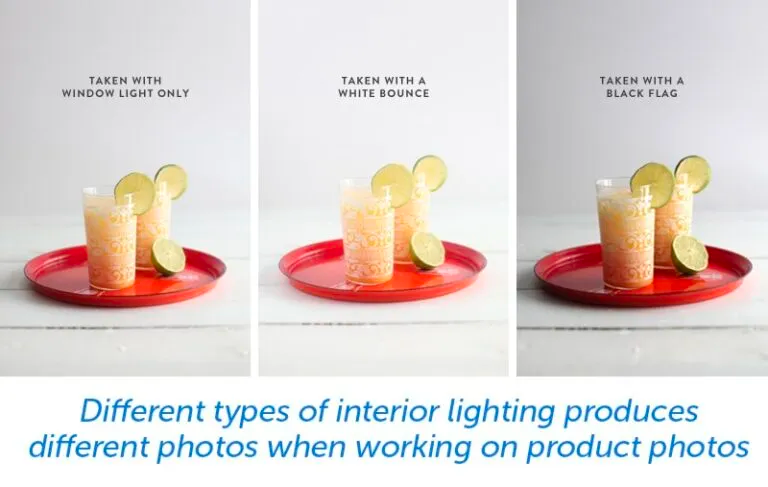Make sure your product photos are exceptional.
Good product photography isn’t cheap, and cheap product photography isn’t good. DIY product photography can be a false bargain because less-than-stellar photos of your products can drive customers away (and end up costing you sales).
Great photos, on the other hand, generate revenue because 93% of customers consider visual appearance to be an essential part of purchasing decisions. One study found that images have a strong influence on price sensitivity.

When you need to hire a professional to take care of your ecommerce product photography, it’s important to know what questions to ask. Once you have the answers, you can better evaluate your candidates and find the right person to get the job done. There’s a major difference between amateur and professional product photography.
Another thing to keep in mind is what kinds of photos will be best for your brand and product pages. We’ll touch on that later.
Let’s look at some critical questions to ask a freelance photographer before you hire them.
1. What Kind of Equipment Do You Use?
There’s almost no limit to the number of gadgets and tools a photographer can employ to get the perfect shot, but by knowing what sort of pictures you need, you’ll have a better sense of what equipment those shots will require. This is a key screening question because it will help you evaluate a photographer’s skill level and expertise.
Here are some contextual examples of how this question is relevant for your search:
- Do your product photos need a flawless white background (known as a “Packshot” in the world of ecommerce)? This background will call for a specific type of lighting.
- Do you want to showcase the fine details of a product? You’ll want to make sure the photographer has a macro lens and knows how to use it.
Remember: Equipment includes software, too. As ExpertPhotography notes in their post on lighting and equipment, the right tools can be as simple as a mirror, a good lens, and an interesting background — but you need to hire a photographer who knows how to use them.
Find out what photo editing programs your photographer uses and what their policy is concerning editing and production. Depending on the look you want, processing can take much longer than the actual shoot.
Software can also cover up sloppy technique. You don’t want to be invoiced for the time a photographer spends correcting their own mistakes. Ask about their production process and how they price that part of their work.
2. How Many Photos Can We Expect to Receive?
You’ll want to have several images per product on your site. A single image often doesn’t show enough of the product to convince a buyer. Find out how many images are included in your photographer’s rate and ask how they are organized.
You’ll also want to know the average turnaround time for images from the shoot to final edited versions. This will be important if you’re working on a launch schedule and need to meet deadlines. Ask about availability and turnaround times from the get-go, and have your photographer commit to a deadline in writing.
3. Are You Insured?
Ask to see a copy of your photographer’s insurance policy. Are they covered if products get damaged or somebody gets hurt during the shoot? The time to answer these questions is before something happens.
It’s also a good idea to ask about the photographer’s deposit policy. You can expect to lose your deposit if you have to cancel, but what if the photographer has to cancel? Do you get your deposit back? Talking about money can feel intimidating at times, but you’ll want to get these details out of the way before making a commitment.
4. What Is Your Experience/Background?
Experience with product photography is critical because you need someone who knows not just how to shoot products, but how to handle them as well.
A skilled photographer knows how to work with items that attract dust, have reflective surfaces, or show fingerprints, for example. This experience can mean the difference between showcasing smudges and literally getting the white glove treatment.
Don’t underestimate the value of experience in terms of years in the photography business. A photographer who has more experience is usually better at adapting to unforeseen issues that may come up (because they’ve been there before.) Ask about the number of shoots they’ve done. Don’t be afraid to ask for references while you’re at it.
5. Can I See a Portfolio?
When in doubt, look to a photographer’s past work. If their entire portfolio is landscapes or family portraits, this might not be the person for the job. Try to find someone whose portfolio reflects experience doing work that’s as close as possible to your project.
If you love someone’s portfolio, don’t be afraid to go with the less experienced but more impressive photographer. You can get good value for your money this way.
Call those references, too. Find out what went into the finished shots you see in a portfolio. Did the photographer get it right the first time, or have to go back and forth with the client?
6. What’s Your Style?
Photography is as stylistically diverse as music. If you were hiring a band, one of your first questions would be what style of music they play, right?
Different photographers will deliver different styles, and different styles come with different setup requirements. Ask for a general description of the photographer’s style and review his/her portfolio through this lens. Make sure their primary style strengths match what you are looking for.
7. Do You Shoot in Natural Light or Studio Light?
Lighting is a marketing decision. Which sort of lighting suits your brand? Both natural and studio light present logistical challenges to consider ahead of time.
- Natural light is best for showcasing products being worn or used, or in a realistic environment.
- Artificial light is best for capturing details and emphasizing the product on its own.
Natural lighting depends entirely on the location, the time of day, and that most unpredictable factor, weather.
For studio lighting, are you bringing your products and models and whatever else you need into the photographer’s studio, or are they coming to you? Do you have space for them to set up?

Making Nice in the Midwest explains how different types of lighting produce different photos when working on product photos.
You’re going to want to figure out as much of the lighting as possible ahead of time and discuss the logistics in detail. The last thing you want is to deal with scheduling conflicts for a shoot during “the golden hour” or a rain delay or a location that doesn’t have the right light.
8. What Does Your Fee Include?
You need to know what you’re actually paying in extra fees. Ask for a breakdown of the total cost.
Some photographers charge a studio fee and an extra fee for retouching. Some photographers will charge for travel, or for rental equipment. Find out not only the cost of your project but how much it could cost with all the extras.
9. What Are the Rights to the Photos?
Get this in writing, as the last thing you want is to have a simple product photoshoot turn into an intellectual property dispute. Unless otherwise agreed in writing, the images belong to the photographer by default. An experienced photographer will provide a contract — this will protect both of you.
Many photographers charge a digital rights fee. This is not the same thing as copyright, and it needs to be spelled out in your contract.
10. Do We Supply a Shot List? Is There a Creative Director Managing the Shoot?
Communication is key. Make sure you understand each other completely before you sign anything or put anyone on the clock. Everyone should know who’s in charge of creative direction for the shoot.
Be clear about what kind of guidance and input your photographer expects from you (and vice versa) at every stage of the project.
Hire a Product Photographer with Confidence
The more you know about what goes into professional product photography, the easier it will be to get yourself on the same page as a photographer who can deliver it. These questions should give you more than enough info to make an educated choice when hiring a photographer to create amazing product photos, which will help to create product pages that sell more products.
Need an Ecommerce Hosting Solution?
Managed WooCommerce Hosting from Nexcess comes standard with image compression which will keep your images looking excellent while retaining site speed, along with premium plugins from IconicWP which will enable more functionality for your product pages to shine.

